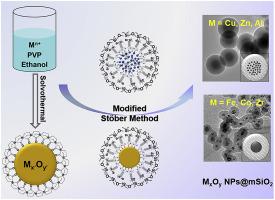Microporous and Mesoporous Materials ( IF 5.2 ) Pub Date : 2020-06-26 , DOI: 10.1016/j.micromeso.2020.110381 Huanhuan Yang , Xiaojing Cui , Shiying Li , Youliang Cen , Tiansheng Deng , Jianguo Wang , Unni Olsbye , Weibin Fan

|
Our previous work reports synthesis of a highly stable watermelon-like CuO NPs@mSiO2 core-shell material (CuO nanoparticles embedded in mesoporous silica) by a modified Stöber method. Here, its formation mechanism is unraveled by investigating the effects of synthesis parameters, i.e. polyvinylpyrrolidone (PVP) and cetyltrimethyl ammonium bromide (CTAB) concentrations, copper nitrate and tetraethyl orthosilicate (TEOS) amounts, as well as alkali types and amounts, on the solid product structure and particle morphology for the purpose of developing a general method for synthesis of single and composite metal oxide NPs@mSiO2. With such a method, various types of metal oxide NPs@mSiO2 have been synthesized. It is shown that the structure and particle morphology of these core-shell materials are not only related to the synthesis parameters, but also dependent on the types of metal oxides. More interestingly, these core-shell materials are potential for facilely fabricating bifunctional catalysts by further modifying mSiO2 shell or coating another type of catalyst such as zeolites.
中文翻译:

阐明金属氧化物纳米粒子在介孔二氧化硅壳中的形成机理的通用方法
我们以前的工作报道了通过改良的Stöber方法合成高度稳定的西瓜状CuO NPs @ mSiO 2核壳材料(CuO纳米颗粒嵌入中孔二氧化硅中)。在这里,通过研究合成参数,即聚乙烯吡咯烷酮(PVP)和十六烷基三甲基溴化铵(CTAB)的浓度,硝酸铜和原硅酸四乙酯(TEOS)的量以及碱的类型和量对固体的影响,来阐明其形成机理。产品结构和颗粒形态,目的是为了开发一种合成单一和复合金属氧化物NPs @ mSiO 2的一般方法。通过这种方法,各种类型的金属氧化物NPs @ mSiO 2已经合成。结果表明,这些核壳材料的结构和颗粒形态不仅与合成参数有关,而且还与金属氧化物的种类有关。更有趣的是,这些核-壳材料具有通过进一步修饰mSiO 2壳或涂覆另一种类型的催化剂(例如沸石)来方便地制造双功能催化剂的潜力。

























 京公网安备 11010802027423号
京公网安备 11010802027423号